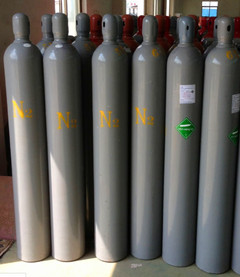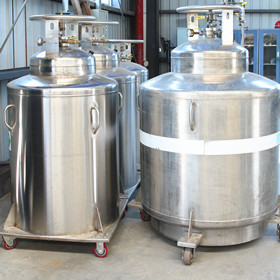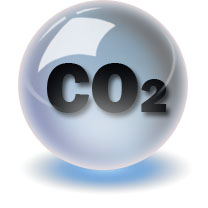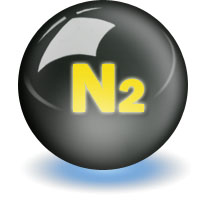歡迎蒞臨廣州譜源氣體有限公司
聯(lián)系粵佳
廣州市譜源氣體有限公司


安全知識-Gaseous Argon氬氣
2008-8-23 11:49:00 [點擊下載:2008823113122607.doc]
Gaseous argon is tasteless, colorless, odorless, non corrosive, and nonflammable. Argon belongs to the family of rare inert gases. It is the most plentiful of the rare gases making up approximately 1% of the earth’s atmosphere. It is monatomic and extremely inert, forming no known chemical compounds.
氣態(tài)氬無味,無色,無嗅,無腐蝕性,不可燃。氬屬于稀有惰性氣體家族。它是最豐富的稀有氣體,占地球空氣的約1%。它是單原子,極不活潑,沒有已知的化合物。
Special materials of construction are not required to prevent corrosion. Vessels and piping should be designed to American Society of Mechanical Engineers (ASME) or Department of Transportation (DOT) codes for the pressures and temperatures involved.
不要求特殊的建材來防止腐蝕。容器和管道系統(tǒng)要根據(jù)相關(guān)的壓力和溫度按照美國機械工程師協(xié)會(ASME)或交通部(DOT)的規(guī)定來設(shè)計。
Argon may be compressed into cylinders by water or oil-lubricated compressors or by dry compression systems. To determine the amount of argon in a cylinder, use the appropriate pressure and temperature capacity chart for a specific size cylinder. (The higher the pressure, the larger the amount of argon in the container.)
氬可以使用水或油潤滑的壓縮機或干壓縮系統(tǒng)壓縮進鋼瓶。要確定鋼瓶的氬容量,對于特定尺寸的鋼瓶使用合適的壓力和溫度容量表。(壓力越大,容器的氬容量越大)
Manufacture生產(chǎn)
Argon is produced by an air separation unit(ASU) through the liquefaction of atmospheric air and separation of the argon by continuous cryogenic distillation. The argon is then removed as a cryogenic liquid.
氬的生產(chǎn)使用空氣分離裝置(ASU),通過大氣的液化和連續(xù)低溫蒸餾分離出氬。隨后,氬作為低溫液體運輸。
The ASU manufacturing process begins with a main air compressor and ends at the output of the product storage tanks. Air is compressed and sent through a clean-up system where moisture, carbon dioxide, and hydrocarbons are removed. The air then passes through heat exchangers where it is cooled to cryogenic temperature. The air then enters a high pressure distillation column where it is physically separated into a gaseous form of nitrogen at the top of the column and a liquid form of “crude” oxygen (~90%) at the bottom.
ASU生產(chǎn)過程從一個主氣流壓縮機開始,產(chǎn)品儲存罐的輸出后結(jié)束??諝馔ㄟ^一個去除了水蒸汽、二氧化碳和碳?xì)浠衔锏那鍧嵪到y(tǒng)壓縮和輸運。接著空氣通過熱交換器冷卻到低溫。隨后空氣進入高壓分裂蒸餾塔,分離成氣態(tài)氮和“原始”液氧(含大約90%的氧),氮蒸氣在蒸餾塔頂部,液氧在蒸餾塔底部。
Argon is the major contaminant in this crude oxygen, which is then sent to a low-pressure distillation column where the oxygen is purified. The argon-rich waste stream from the low pressure column is sent to an argon distillation column. Some argon technologies distill the argon directly to its final manufacturing purity, while others utilize a separate step to purify it, for example, hydrogen deoxo. Purified argon is stored as a liquid in storage tanks at the site.
氬是原始氧中最大的雜質(zhì)。接著把原始液氧送到低壓分裂蒸餾塔凈化。從低壓塔流出的富氬廢物被送到氬分裂蒸餾塔。某些氬技術(shù)直接把氬蒸餾到最終的生產(chǎn)純度,而其它技術(shù)采用分離的步驟來凈化它,例如氫脫氧。凈化的氬以液態(tài)形式儲存在現(xiàn)場的儲存罐。
- 核磁共振等行業(yè)可能受氦氣短缺影響成本上升2019-06-05
- 環(huán)境監(jiān)測中的光譜學(xué)技術(shù)進展2018-12-13
- 氫氣已被多國列為食品添加劑2018-11-27
- 塞拉尼斯將收購林德在得克薩斯氫氣和一氧化碳工..2018-11-24
- 甲醇市場持續(xù)下跌2018-11-22
- 普萊克斯在美國新建液氫工廠2018-11-08
- 大連化物所實現(xiàn)二氧化碳直接加氫制取芳烴2018-11-07
- 氦氧混合潛水作業(yè)成功打撈重慶萬州墜江公交車2018-11-03
- 馬鋼氣體成功研制出高純氮氣和高純氬氣2018-10-30
- 為什么說氦氣是天然氣體中被忽視的“黃金”2020-01-10
廣州市譜源氣體有限公司 粵ICP備08114730號
地址:廣州市增城新塘西洲大王崗工業(yè)區(qū)
全國熱線電話:19876107228
公司電話:19876107228
公司傳真:020-82797482
聯(lián)系郵箱:[email protected]
地址:廣州市增城新塘西洲大王崗工業(yè)區(qū)
全國熱線電話:19876107228
公司電話:19876107228
公司傳真:020-82797482
聯(lián)系郵箱:[email protected]







